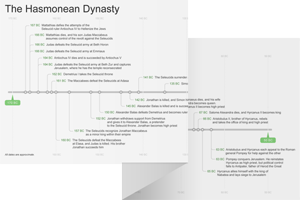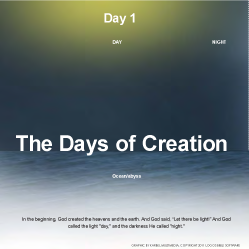31:1–30 This oracle of salvation continues the theme of rebuilding Israel and reestablishing the people. The oracle uses references to Israel, Ephraim, and Samaria—names for the northern kingdom—in an inclusive way to emphasize the total restoration of Israel and Judah. The promised restoration is grounded fully in the love of Yahweh for His people (Jer 31:3, 20). The poetic imagery is reminiscent of the exodus story, the Israelites’ wilderness wandering, and their establishment as a nation in the land of Canaan. |
31:1 all the clans of Israel Emphasizes the complete restoration of all 12 tribes of Israel—both Israel and Judah. The northern kingdom was defeated and its 10 tribes taken into exile in 722 bc, nearly a century before Jeremiah was born.
31:2 found grace in the desert Alludes to the wilderness wandering, depicting it as a time of close relationship between Yahweh and Israel (compare 2:2–3; Exod 33:12–17).
31:4 You will again adorn yourself with your tambourines Alludes to the exodus traditions—when Yahweh established Israel—to encourage their faith in His plan to rebuild Israel (compare Exod 15:20).
31:5 the mountains of Samaria Refers to the northern kingdom of Israel. Samaria was the former capital city of Israel, and the place-name was also applied to the surrounding region.
31:6 the hill country of Ephraim A reference to the northern kingdom of Israel. See note on Ezek 37:16.
to Zion Refers to the Temple Mount in Jerusalem (see note on Isa 1:8). The depiction of the northern kingdom seeking Yahweh at Zion—located in the southern kingdom of Judah—is a surprising reversal of the north’s earlier rejection of Zion (1 Kgs 12:26–33) and a statement of Israel and Judah’s reunification. Compare Isa 2:3.
31:7 Jacob A poetic reference to all Israel. Jacob’s 12 sons founded the 12 tribes of Israel (see Gen 35:22–27; 49:2–28).
the remnant of Israel In salvation oracles, the remnant often refers to the scattered survivors of judgment who will be gathered back to Israel through Yahweh’s act of redemption (compare Isa 4:2; 11:11; 49:22). See note on Isa 1:9; note on Jer 24:8.
31:8 the land of the north The exiles were taken north as the invaders returned the way they came. The motif of invasion from the north (see 1:14 and note) is reversed to depict the exiles returning from the north.
the blind, and the lame Physical infirmities will not hinder the return (compare Isa 35:5–6).
31:9 With weeping Symbolizes genuine repentance (see Jer 31:30–34).
I will let them walk by streams of water Imagery reminiscent of Isa 35:6–8. Salvation oracles often use images of a renewed creation. Compare Isa 43:19.
I have become to Israel a father The metaphor of Yahweh as a father is common in the ot (compare Jer 3:19; 31:20; Hos 11:1; and Zech 12:10).
Ephraim, he is my firstborn Compare Exod 4:22. The reference to firstborn raises Israel’s importance from that of “son” to “most favored son.” In biblical law, the firstborn received a double portion of the inheritance.
31:10 the coastlands Often used to refer to the farthest reaches of the known world (see Isa 11:11; 41:1; 60:9).
The scatterer of Israel will gather him The scattering was part of the covenant curses (Lev 26:33), but the restoration and gathering also was promised (Deut 30:1–4). Compare Jer 9:16; 10:21; 30:11; Ezek 36:19, 24.
a shepherd his flock The metaphor of Yahweh as a shepherd caring for His flock is common in the ot (see Isa 40:11 and note; and Ezek 34:11 and note; compare Ezek 34:11–16).
31:11 Yahweh has ransomed Jacob The image of salvation in the formal sense of a legal ransom or act of redemption is a common feature in Isa 40–48 (e.g., Isa 43:1; 44:22; 48:20). See note on Isa 43:3, and note on Exod 6:6.
31:12 life will become like a well-watered garden The imagery of this verse points to the future blessing on the land that results when God’s people are in right relationship with Him (compare Isa 35:10; 58:11).
31:15 A voice is heard in Ramah Quoted in Matt 2:18.
Ramah A village in the territory of Benjamin, about 8 miles north of Jerusalem and a few miles northwest of Anathoth. The town was located close to the main north—south highway and appears to be the site where the captives were assembled for exile after the fall of Jerusalem (see Jer 40:1).
Rachel is weeping for her children Rachel was Jacob’s favorite wife (Gen 29:30) and the mother of Joseph and Benjamin. According to one Israelite tradition, her tomb was in Benjaminite territory, north of Jerusalem (1 Sam 10:2).
31:16 they will return Consolation through the promise of restoration. Compare the consolation of personified Zion in Isa 54:1–3.
31:17 hope for your future Compare Jer 29:11.
31:19 struck my thigh A gesture of distress and mourning (see Ezek 21:12).
31:21 Return, O virgin of Israel Encourages the exiles to prepare for return. They need to act to show their faith in Yahweh’s plan to redeem.
31:22 How long will you waver, O unfaithful daughter? The criticism shows their hesitancy to trust in Yahweh’s plan.
Yahweh has created a new thing Asserts that the people can trust Yahweh, even though their present circumstances had overturned their understanding of Him and His relationship with them.
a woman, she shelters a man This phrase is open to many translations and interpretations. It might reflect a proverbial saying whose precise nuance has been lost. The form of the Hebrew verb used here, savav, seems to mean “surround,” “encompass,” or “encircle.” It likely means that Israel embraces Yahweh.
31:23 Judah and in its towns An oracle affirming the restoration of Judah with imagery similar to that for the restoration of Israel in vv. 2–6.
31:26 my sleep was pleasant to me A first-person reaction to the vision of restoration, suggesting that Jeremiah received the revelation through a dream.
31:27 with the seed of humankind Compare Ezek 36:9–11.
31:29 Parents have eaten unripe fruit This proverb, which also appears in Ezek 18:2, carries an implicit criticism of Yahweh for punishing people for the sins of others. The proverb is succinctly refuted in Jer 31:30 with the assertion that everyone is punished for their individual sin. Ezekiel might be quoting from Jeremiah here and expanding on the concept more fully. See note on Ezek 18:2; compare Ezek 18:1–32 and note.
31:30 each will die because of his iniquity Compare Ezek 18:4.
31:31–34 A new covenant is necessary because Israel’s sin invalidated the Mosaic covenant (see note on Jer 11:12). The internal transformation of the people makes it possible for them to obey the law and live righteously. Compare Ezek 11:19; 36:26–28. |
31:31 I will make a new covenant The new covenant involves an internalization of Yahweh’s law. The law will be written on their minds and hearts, so there will be no need to teach the people about Yahweh or about the law. The phrase in Hebrew expresses the idea of making a covenant with the idiom cut a covenant (see note on 1 Sam 11:1).
(see note on 1 Sam 11:1).
31:33 and I will be to them God A common covenant formula (see Jer 30:22 and note).
31:35–40 Yahweh’s power is manifested in His act of creation, establishing and maintaining the natural order. His sovereignty over all things offers assurance that the promised salvation will come to pass. This passage contains a hymn-like oracle of salvation that emphasizes God’s creative power followed by a declaration that Jerusalem will be rebuilt, expanded, and purified. The hymnic language of creation used in vv. 35–37 is common in the poetry of Isaiah (see Isa 40:12, 26; 42:5; 44:24; 45:7, 18; 54:10). See Gen 1:16. |
31:38 the Tower of Hananel to the Corner Gate Locations on the northern and western sides of the city. The description of the boundaries of Jerusalem (Jer 31:38–40) starts on the north side and moves counterclockwise. Jerusalem was most vulnerable to attack from the north, as steep valleys on the east and southwest provided natural defense.
31:39 the hill of Gareb An unknown location.
to Goah Also unknown.
31:40 valley of the corpses Refers to the Hinnom Valley, where child sacrifices to the Canaanite deity Molech were performed (see note on Jer 7:31). This valley bordered Jerusalem to the west and south.
the wadi of Kidron The Kidron Valley bordered Jerusalem on the east.
the corner of the Gate of the Horses The southeast corner of the city. See Neh 3:28 and note.

|
About Faithlife Study BibleFaithlife Study Bible (FSB) is your guide to the ancient world of the Old and New Testaments, with study notes and articles that draw from a wide range of academic research. FSB helps you learn how to think about interpretation methods and issues so that you can gain a deeper understanding of the text. |
| Copyright |
Copyright 2012 Logos Bible Software. |
| Support Info | fsb |
 Loading…
Loading…



